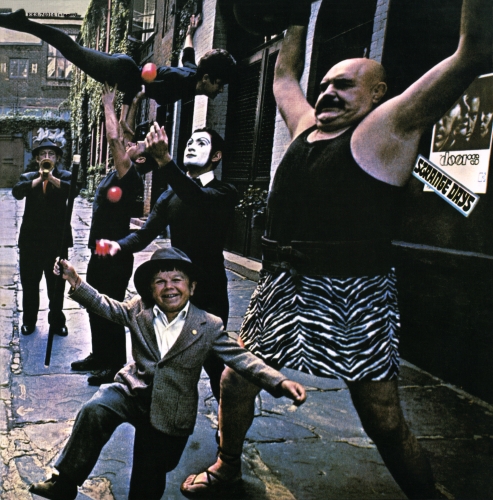

Strange Days
Studio album by The Doors
Released September 25, 1967
Recorded March–May 1967 at Sunset Sound Recorders, Hollywood, CA
Genre Psychedelic rock, acid rock
Length 35:25
Label Elektra
Producer Paul A. Rothchild
Strange Days is the second album released by American rock band The Doors. The album was a commercial success, earning a gold record and reaching No. 3 on the Billboard 200 albums chart. Despite this, the album's producer, Paul Rothchild, considered it a commercial failure, even if it was an artistic triumph: "We all thought it was the best album. Significantly, it was also the one with the weakest sales. We were confident it was going to be bigger than anything The Beatles had done. But, there was no single. The record died on us." Nonetheless, the album managed two Top 30 hits, a Top 3 placing on the US charts, and a platinum certification. Furthermore, the album certainly did nothing to derail the overall success of The Doors, as demonstrated the next year by their chart-topping follow-up Waiting for the Sun.
Strange Days consists of songs that were written in 1965-1966, but did not make it onto their debut album, such as "Moonlight Drive", which was one of the first songs written by Jim Morrison. The song was recorded in 1965 (demo) and 1966 (intended for their first album). In 1967 a final version was recorded and released on this album. Strange Days contains some of The Doors' most psychedelic songs. It includes songs such as "Strange Days", "People Are Strange", "Love Me Two Times" and "When the Music's Over".
Reception
Professional ratings
Allmusic 3.5/5 stars
George Starostin 14/15 stars
Music Box 5/5 stars
Slant Magazine 4.5/5 stars
Rolling Stone
Strange Days reached #3 in the US in November 1967, while the band's debut, The Doors, was still sitting in the Top 10. "People Are Strange" shot to #12 on the US chart, and "Love Me Two Times" followed it, going to #25, thus proving The Doors' staying power after the runaway success of their debut. In the UK the band had yet to score a big hit single and Strange Days became one of two Doors studio albums not to chart, despite subsequent strong sales. In 2003, Strange Days ranked #407 on Rolling Stone's The 500 Greatest Albums of All Time.
Artwork
Unlike all of the band's other studio albums throughout their time with Morrison, the cover is not a group shot of the band, because of Morrison's refusal to appear on the cover. Joel Brodsky decided to photograph a group of street performers in New York. The location of the photograph is at Sniffen Court, a residential alley between Lexington and Third Avenue in Manhattan. The availability of such performers pictured was low, so Brodsky's assistant stood in as a juggler while a random cab driver was paid $5 to pose playing the trumpet. Two twin dwarves were hired, with one appearing on the front cover and one appearing on the back cover, which showed another shot of the alley. However, a group shot of the band does appear on a poster in the background of both shots, bearing captions of the band and album name (the same photograph previously appeared on the back cover of the band's self-titled album). Because of the subtlety of the artist and album title most record stores put stickers across the cover help people identify it more clearly.
Track listing
All songs written by The Doors (Jim Morrison, Robby Krieger, Ray Manzarek and John Densmore).
Side one
"Strange Days" – 3:11
"You're Lost Little Girl" – 3:03
"Love Me Two Times" – 3:18
"Unhappy Girl" – 2:02
"Horse Latitudes" – 1:37
"Moonlight Drive" – 3:05
Side two
"People Are Strange" – 2:13
"My Eyes Have Seen You" – 2:32
I Can't See Your Face in My Mind" – 3:26
"When the Music's Over" – 10:58
Personnel
The Doors
Jim Morrison – lead vocals, Moog synthesizer on track 1[8]
Ray Manzarek – Vox Continental organ, Fender Rhodes piano bass on tracks 4 and 10, harpsichord on track 3, backwards piano on track 4, marimba on track 9, backing vocals
Robby Krieger – guitar
John Densmore – drums
Additional musicians
Douglas Lubahn – bass guitar on tracks 1, 2, 3, 6, 7, 8, 9
Technical staff and artwork
Bruce Botnick - engineer
Joel Brodsky - cover photography
William S. Harvey - cover concept & art direction
Jac Holzman - production supervisor
Paul A. Rothchild - producer